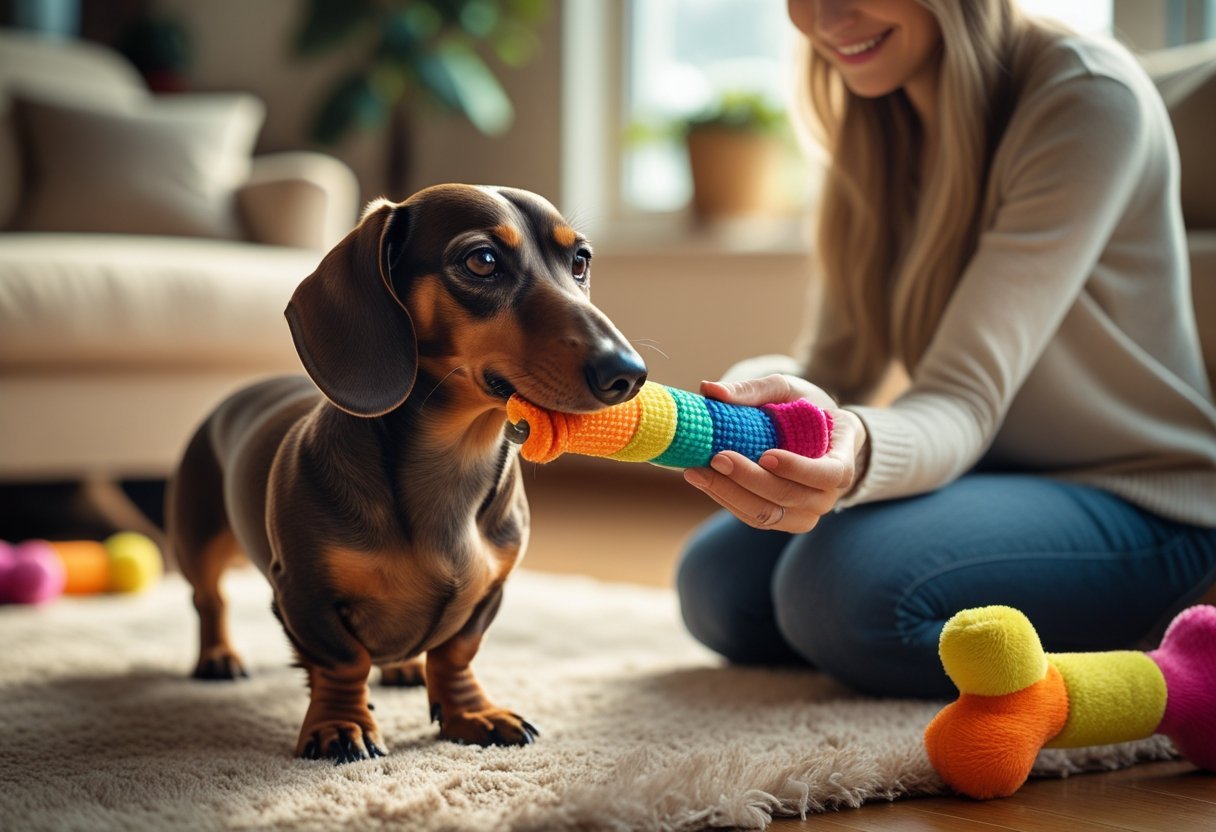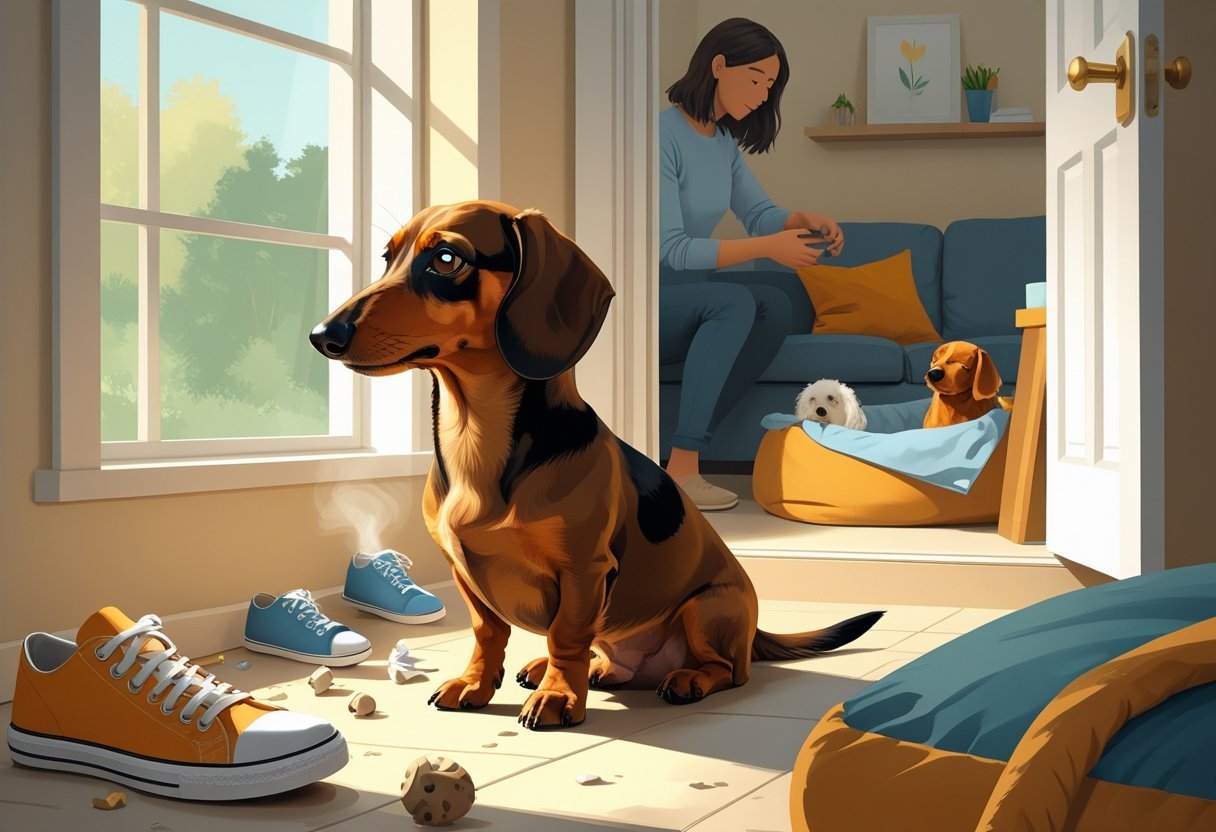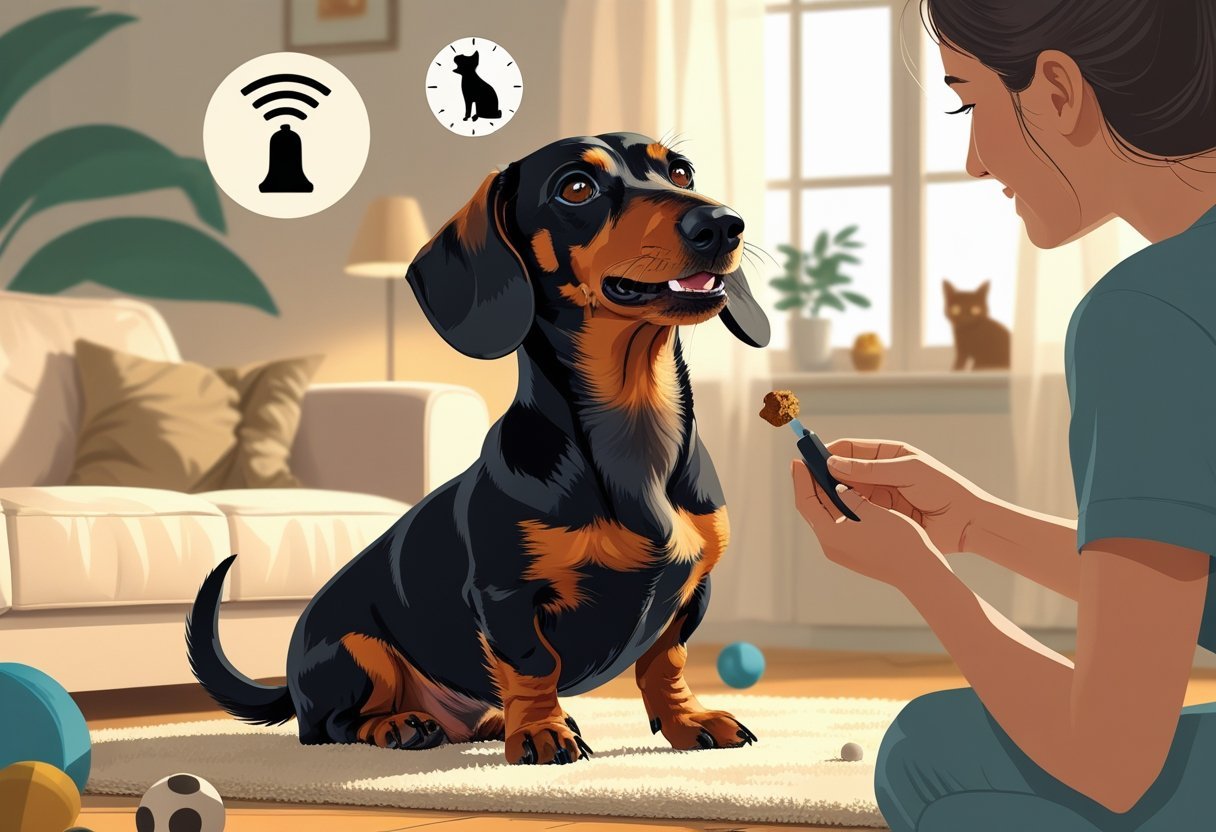Dachshunds really love to chew—it’s just in their nature as a hunting breed 🐾. Your wiener dog uses their mouth to explore, ease boredom, and soothe teething pain 🦴.
Understanding why your dachshund chews is the first step to managing this behavior and stopping it from turning destructive 🎯.
If your dachshund has started destroying shoes, furniture, or other household items, don’t panic 🚫. You can redirect this behavior with training, good toys, and clear boundaries ✅.
Most chewing problems come from boredom, anxiety, or a lack of proper outlets for their instincts 💡.
Key Takeaways ✨
- Dachshund chewing is normal but needs guidance through training and the right chew toys 🐶.
- Destructive chewing often signals boredom, anxiety, or teething that needs your attention ⚡.
- Dog-proofing your home and offering mental stimulation can prevent chewing problems and protect your stuff 🏡.
🐾 Free Dachshund Care Guide
Download our free checklist to ensure your Dachshund stays happy, healthy, and well-loved!
Get Your Free Guide 🐶Understanding Dachshund Chewing Behavior
Dachshunds have strong chewing instincts from their hunting background 🐾. If you know what triggers your doxie to chew, you can get ahead of any problems 🎯.
Why Dachshunds Chew 🦴
Dachshunds were bred to hunt badgers and burrowing animals, so they needed strong jaws and determined digging skills 🐕. That hunting heritage explains why your dachshund loves to chew and dig 🌿.
Chewing helps relieve teething pain in puppies as their adult teeth come in 🐶. For adults, it keeps their teeth clean and jaws strong 💪.
Chewing also gives mental stimulation and can ease boredom or anxiety 🧠. Sometimes, your dachshund just wants to explore with their mouth—dogs learn about objects by mouthing them, a bit like how humans use their hands 👅.

🥦 Wild Earth Plant-Based Dog Food – Gentle Nutrition for Chewers
Clean, plant-powered recipe that keeps your Dachshund’s tummy happy 🌿 and helps reduce stress chewing linked to poor diet.
- Balanced formula supports long-term health 🙂
- Vet-developed and easy to digest 🌱
- Great for sensitive pups prone to chewing from anxiety 🐾
Common Triggers for Chewing in Doxies 🔑
Lots of things can spark chewing behavior in your dachshund:
- Boredom – Dachshunds are smart and energetic. If they don’t get enough to do, they’ll chew for fun 🎲.
- Anxiety and stress – Changes in routine, being left alone, or other stress can lead to anxious chewing 💔.
- Teething discomfort – Puppies between 3-7 months chew more because it helps with teething pain 🍼.
- Attention-seeking – Sometimes your doxie notices that chewing gets your attention, even if it’s negative 👀.
- Hunger – Dogs might chew non-food items if they’re hungry or missing something in their diet 🍽️.
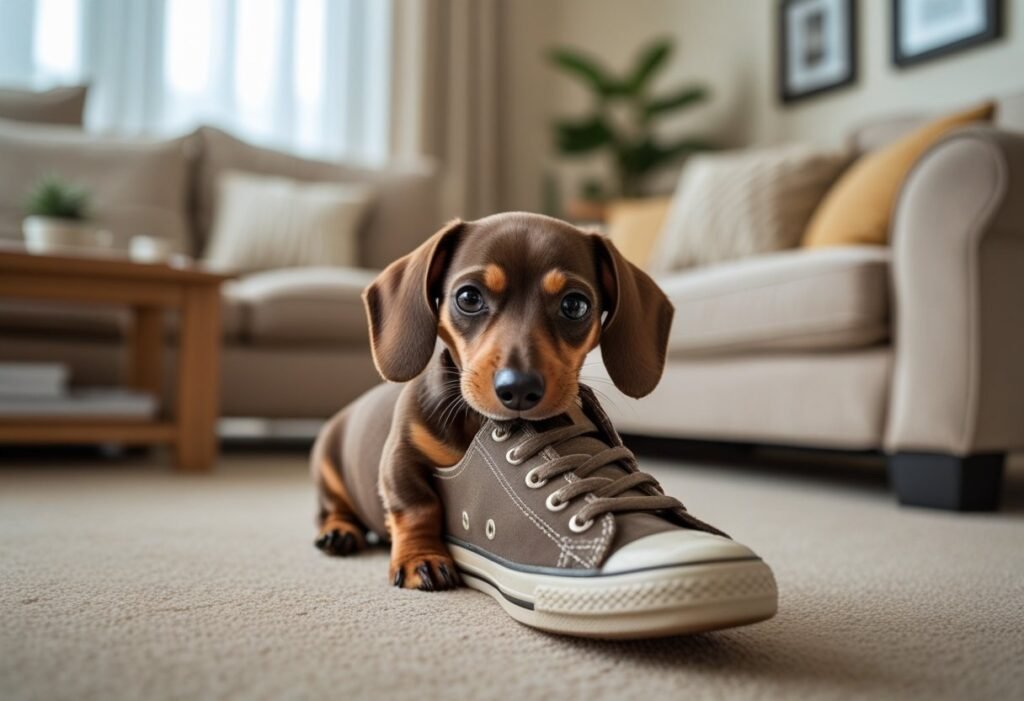
When Chewing Becomes a Problem ⚠️
Chewing becomes a real issue when your dachshund keeps going after things like furniture, shoes, or cords 🛋️. This can wreck your stuff and even be dangerous 🚫.
If your dachshund chews destructively only when you’re away, separation anxiety might be the cause 🕒. Watch for warning signs:
- Chewing that suddenly increases 📈.
- Obsessively chewing one type of item 🔄.
- Destructive chewing plus other behavior changes ⚡.
- Swallowing non-food items (which can block their intestines) 🧩.
If your dachshund hurts their mouth or swallows something dangerous, call your vet right away 📞. Sometimes, excessive chewing also points to dental problems or pain that needs a professional look 🏥.
Natural vs. Problem Chewing in Dachshunds
Dachshunds, like all dogs, have a natural urge to chew 🐾. But there’s a line between normal chewing and problem chewing that needs fixing ⚠️.
Developmental Chewing in Puppies 🐶
Puppies explore the world with their mouths 👅. Between 3-6 months, teething makes them chew even more, and that’s totally normal 🍼.
Your puppy isn’t trying to be bad—they’re just learning 📘. Offer a mix of chew toys with different textures to help them out 🦴.
If your puppy chews one spot over and over, it might mean they’re in pain 💔. Normal puppy chewing usually drops off after their baby teeth are gone 🦷.
When you catch your puppy chewing something off-limits, calmly swap it for a toy 🔄. Punishing them just makes things worse and can make them anxious 😟.
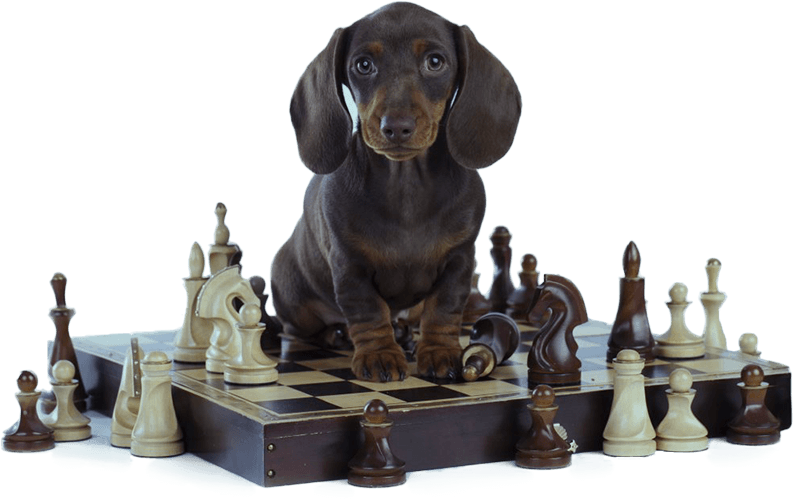
🧠 Brain Training for Dogs – Fun Fix for Chewing Habits
Mental games tire out Dachshunds as much as exercise 🎯—a smart way to redirect chewing into positive learning.
- Step-by-step program designed for small breeds 🐶
- Boosts focus and reduces boredom chewing 🙂
- Fun games that replace destructive chewing with good habits 🛋️

Adult Dachshund Chewing Habits 🐕
Grown-up dachshunds still chew, but not as much as puppies 🎯. Healthy adult chewing happens now and then, usually with toys or treats 🍏.
Here are some warning signs of problem chewing:
- Chewing suddenly increases 📈.
- Destructive chewing when alone 🕒.
- Chewing that causes injury 🚑.
- Chewing focused on furniture corners or walls 🛋️.
These can point to separation anxiety, boredom, or dental issues 🧠. Adult dachshunds need mental stimulation to keep boredom chewing at bay 🎾.
Give them 15-20 minutes of play every day and swap out chew toys each week to keep things interesting 🎲. If your adult dachshund suddenly becomes a chewing machine, check with your vet to rule out dental pain or other problems 🏥.
Consequences of Unmanaged Chewing

If you let chewing go unchecked, your dachshund can cause big problems at home and for their own health ⚠️. The fallout ranges from expensive property damage to emergency vet visits 💸.
Damage to Furniture and Belongings 🛋️
Dachshunds may be small, but their jaws are strong 💪. If they chew too much, your furniture, shoes, and valuables can end up destroyed 🐾.
Wooden furniture legs might end up full of teeth marks or even gnawed through 🪵. Chewed electronic cables aren’t just annoying—they’re dangerous ⚡.
The costs add up fast. One bad chewing spree can ruin:
- Shoes ($50-$200) 👟.
- Furniture ($100-$1000+) 🪑.
- Electronics and cables ($20-$500) 🔌.
- Important papers or sentimental things (sometimes impossible to replace) 📄.
Constantly cleaning up and replacing things gets stressful 😩. It can even put a strain on your relationship with your dog—no one wants to feel annoyed with their own pet ❤️🩹.

🍲 ChefPaw Dog Food Maker
- Make healthy, fresh meals at home
- Control ingredients for sensitive Dachshunds
- Helps prevent anxiety chewing with balanced diet

🛡️ The Swiftest – Pet Insurance Comparison
- Compare top pet insurance providers
- Find coverage for chewing-related emergencies
- Save money with the best plan for your Doxie
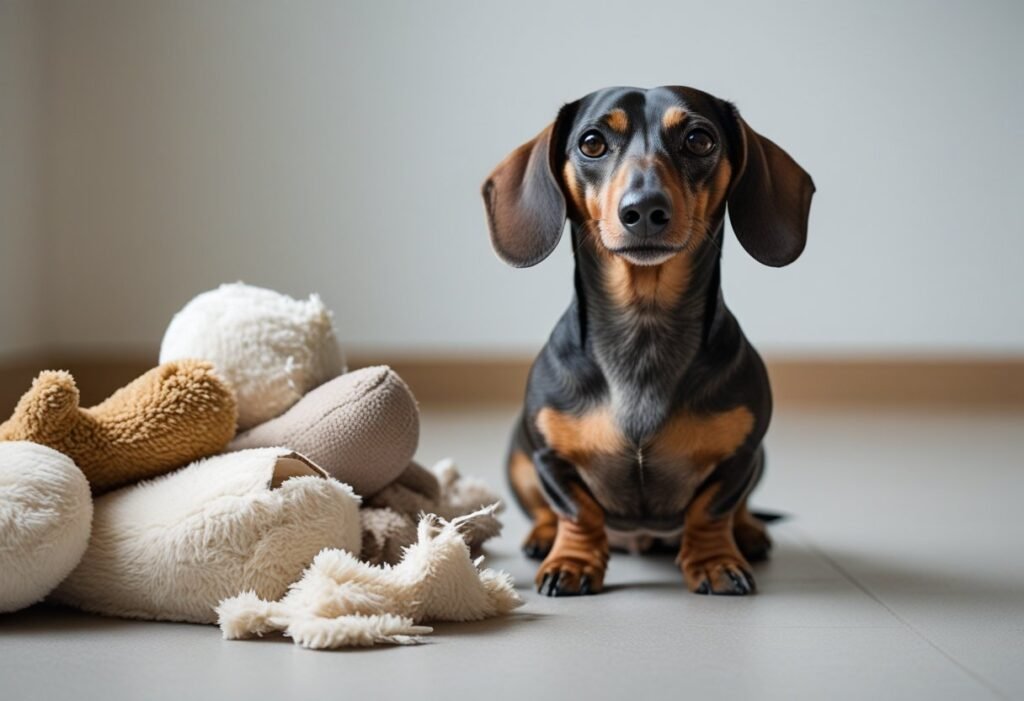
Potential Health Risks to Dachshunds 🩺
Uncontrolled chewing can put your dachshund at risk for several health issues 🚑. Some of these dangers are pretty serious ❗.
If your dachshund swallows something, it could cause a blockage and require emergency surgery 🏥. With their long, narrow bodies, dachshunds are especially at risk 🐕. Symptoms include vomiting, tiredness, or not wanting to eat 🤢.
Chewing hard things can break teeth, which is painful and might mean extractions 🦷. That makes eating tough for them 🍽️.
Some chewed items are toxic. They might contain:
- Chemicals from furniture finishes 🧴.
- Poisonous houseplants 🌱.
- Other harmful household products 🧪.
Splinters from chewed materials can cut your dog’s mouth, throat, or digestive tract 🩹. That can lead to infections or internal bleeding if you don’t catch it quickly ⚡.
Identifying the Causes of Your Dachshund’s Chewing
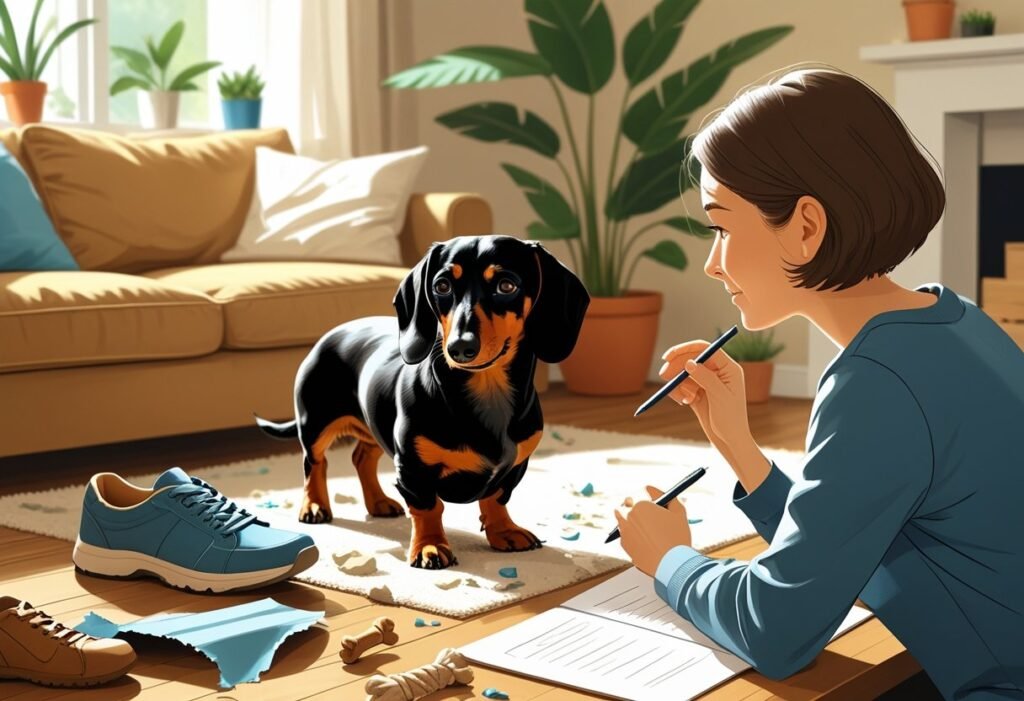
Dachshunds chew for specific reasons 🐾. If you watch their patterns, you can often figure out the cause—and fix it instead of just reacting 🎯.
Boredom and Lack of Stimulation 🎲
Dachshunds are clever and need both mental and physical exercise 🧠. Without enough to do, they start chewing to use up their energy ⚡.
Signs your dachshund chews out of boredom:
- More destruction on days with less activity 🛋️.
- Chewing mostly when alone and bored 🕒.
- Increased interest in toys after exercise 🎾.
These dogs were bred to be busy 🔍. If they don’t get at least 30-60 minutes of exercise each day, they’ll find their own fun—often by chewing 🚶.
Try keeping track of your dog’s chewing versus their activity 📓. You’ll probably see less chewing on days with good walks or playtime 🐕.

🍽️ Petlibro Auto Feeder
- Keeps meals on a reliable schedule
- Portion control helps prevent stress chewing
- Easy to use and clean

🛏️ Majestic Pet Bed
- Soft and supportive for Dachshunds
- Reduces stress and anxiety chewing
- Durable, washable cover for easy cleaning

🎉 Grab your free Dachshund care checklist!
Separation Anxiety and Stress 💔
Dachshunds bond deeply with their owners and can get anxious when left alone 🤗. That stress often shows up as destructive chewing 🚫.
Look for these clues:
- Chewing mostly when you’re gone 🚪.
- Destruction near doors or windows 🪟.
- Other anxiety signs like barking, pacing, or accidents 🐕.
Stressful events like thunderstorms, fireworks, or changes at home can also trigger chewing 🌩️. Dachshunds often go for things that smell like you—shoes, clothes—because it comforts them 👟.
Keep a record of when chewing happens 📝. If it’s always when you’re out, separation anxiety is probably the root cause, not just boredom 🔑.
How to Stop Destructive Chewing in Dachshunds
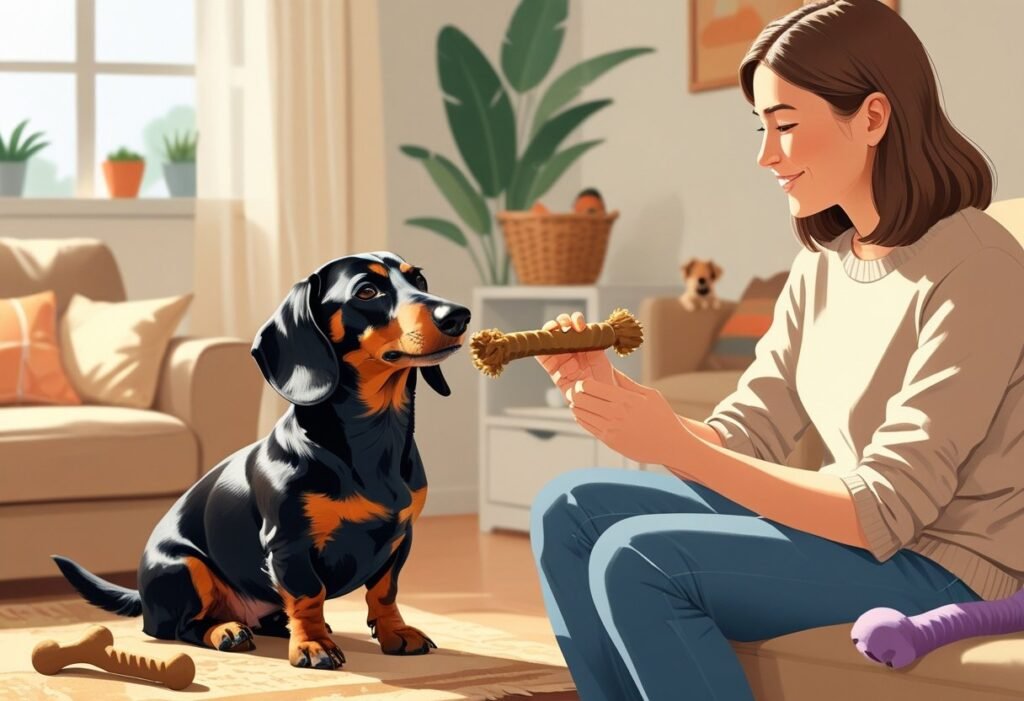
Dachshunds often chew to beat boredom or anxiety 🐾. To manage this, you’ll need to train them consistently and make sure they have good outlets for their chewing instincts 🎯.
Preventing Doxie Chewing Furniture 🛋️
Start by “dachshund-proofing” your home 🏡. Move anything valuable out of reach and spray furniture edges with bitter apple spray 🍏. That stuff tastes awful to dogs and usually keeps them away 🚫.
Give your dachshund daily exercise 🐕. Tired pups just don’t have the energy to chew up your furniture out of boredom ⚡.
Try crate training if you can’t supervise 📦. Pick a crate that’s big enough for them to stand, turn, and stretch out ✨.
Crates keep your dachshund from chewing when you’re busy and help them feel safe in their own little den 🛏️.
Keep their mind busy with puzzle toys that make them think 🧩. Mental stimulation goes a long way in curbing the urge to chew on things they shouldn’t 💡.
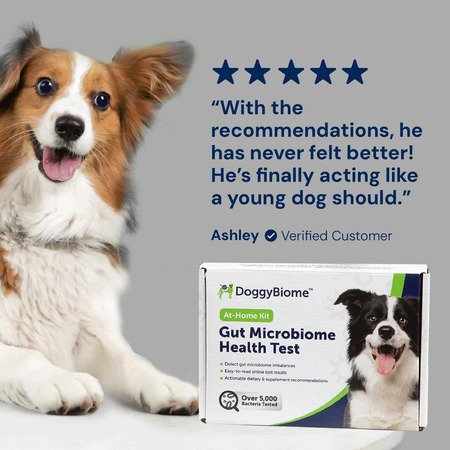
🧬 AnimalBiome Gut Health Test
- Identifies gut imbalances linked to stress chewing
- Simple at-home test kit
- Personalized supplement plan

🌿 Zumalka Natural Remedies
- Homeopathic solutions for anxious chewers
- Gentle and safe for Dachshunds
- Supports calm behavior naturally
Redirecting Chewing to Approved Items 🦴
Pick chew toys that suit your dachshund’s style 🎾. Some love soft plushies, others need tough rubber toys 💪.
Best Chew Toys for Dachshunds:
- Rubber toys (Kong, Nylabone) 🐾.
- Rope toys for tugging 🪢.
- Dental chews for teeth cleaning 🦷.
- Puzzle toys that give out treats 🎁.

If you catch your dachshund chewing something off-limits, say “no” firmly but not harshly 🚫. Hand them an acceptable toy right away so they learn what’s okay to chew ✅.
Switch up their toys every week or so 🔄. Dogs get bored with the same old stuff, but a “new” toy can get them excited again 🎉.
Positive Reinforcement and Training Techniques 🎓
Reward-based training works wonders 🌟. If you spot your dachshund chewing on the right toy, shower them with praise and a treat now and then 🦴.
Teach a command like “leave it” to interrupt bad chewing 🗣️. Start with easy items and work up to things that are more tempting 🧲.
Training Schedule:
- Practice “leave it” for about 5 minutes a day ⏱️.
- Give rewards as soon as they pick the right toy 🍪.
- Stay consistent with corrections for unwanted chewing 🔑.
Skip the punishment—it just makes dogs anxious and can make chewing worse 💔. Focus on rewarding the good stuff instead 🎉.
Clicker training can help 🖱️. It marks the exact moment your dog does what you want, making the connection between chewing right and getting a reward extra clear ✨.
Choosing the Best Chew Toys for Dachshunds
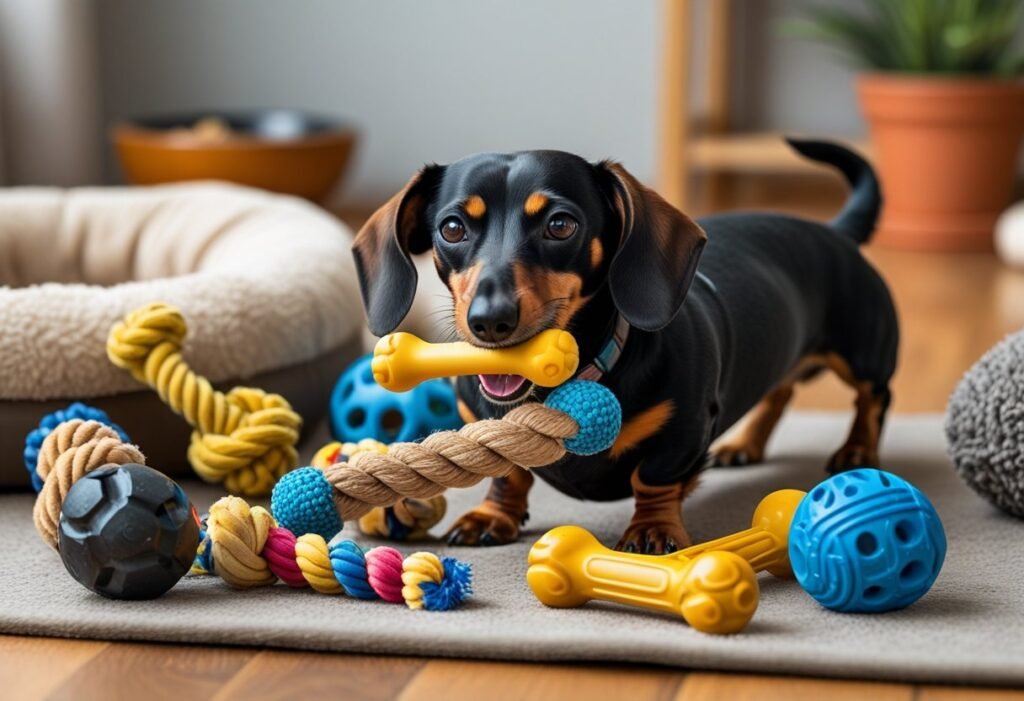
Picking the right chew toys is huge for your dachshund’s dental health and to channel their urge to chew 🦷. Good toys keep your dog happy and help save your stuff from getting destroyed 🐾.
Features of Safe and Durable Chew Toys 🛡️
Find toys made from non-toxic materials that won’t splinter or break into little bits 🚫. Rubber toys like Kongs are tough and can handle a determined chewer 💪.
Size is important 📏. Choose toys small enough for dachshunds to grab, but not so tiny they might swallow them 😟. Nobody wants a choking scare ⚠️.
Texture matters too 🎯. Toys with ridges or nubs clean teeth and feel satisfying to chew 🦴. Some even massage gums and help scrape off plaque ✨.
Steer clear of toys with small parts that could come off and get swallowed ❌. Check toys often for damage and toss them if they start breaking down 🔄.
📍 Tractive GPS Tracker
- Stops outdoor chewing hazards by tracking your doxie in real time
- Safe zones keep them away from dangerous chew targets (like cords or trash)
- Peace of mind when your pup roams

📹 Petcube Cam 360
- Watch and redirect chewing behavior remotely
- Two-way audio lets you comfort anxious pups
- Helps reduce boredom chewing when left alone
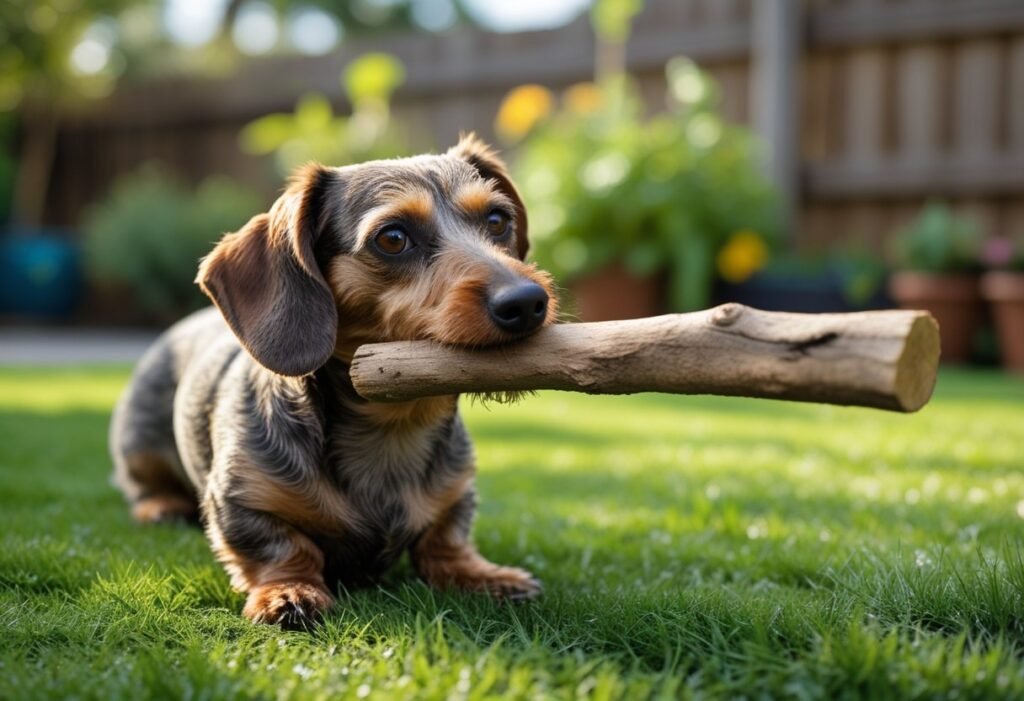
Recommended Chew Toys for Dachshunds 🎾
Top choices for Dachshunds include:
- Rubber toys – Kong Classic or Kong Extreme for strong chewers 🐕.
- Dental chews – Nylabone DuraChew or Greenies (pick the right size) 🦷.
- Rope toys – Great for teeth, but supervise playtime 🪢.
Interactive toys like treat dispensers are awesome for mental stimulation and chewing fun 🧩. The Kong Wobbler or IQ Treat Ball can keep a dachshund busy for ages 🎉.
For teething puppies, try toys you can freeze ❄️. Even a frozen wet washcloth can help soothe their sore gums 🍼.
Rotate toys every week or so 🔄. Having four or five different kinds keeps things interesting and helps toys last longer ⏳.
Supervise play, especially with heavy chewers 👀. Your presence keeps things safe while your dachshund enjoys their favorite toys ❤️.
Creating a Chew-Proof Home Environment
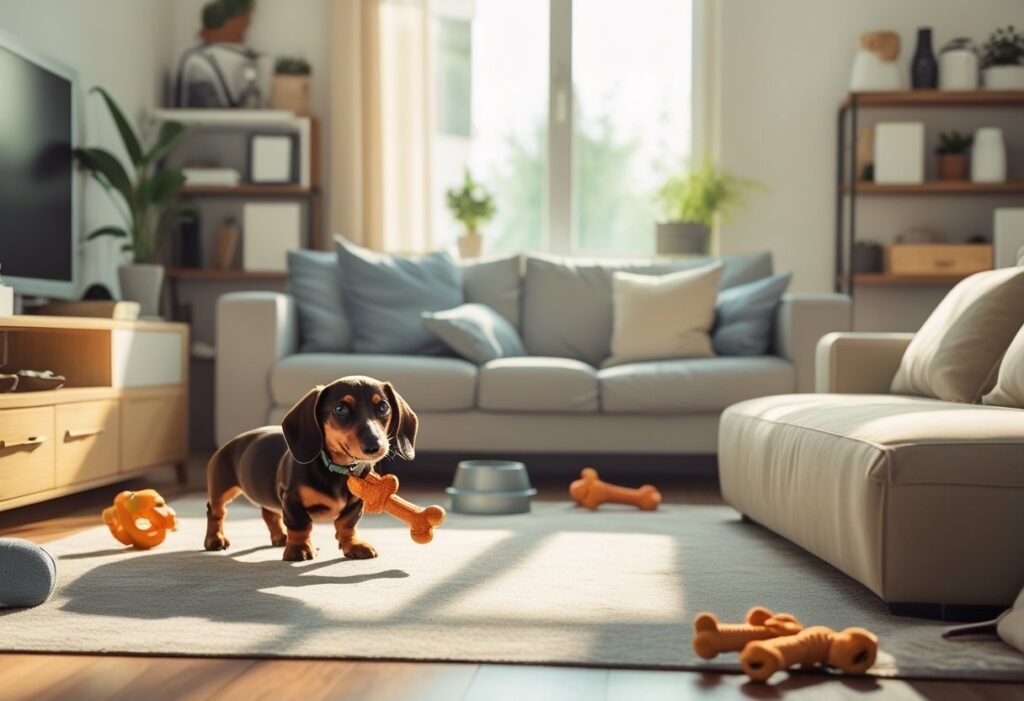
Protecting your home from dachshund chewing takes a little prep and a lot of consistency 🐾. With a few tweaks, you can make your space safer for both your dog and your stuff 🏡.
Dachshund-Proofing Your Living Space 🔒
Put tempting things out of reach. Shoes, kids’ toys, remote controls—they all belong in cabinets or on high shelves 👟.
Cover electrical cords with protectors or tuck them behind furniture. Those cords look way too chewable to a curious pup 🔌.
Spray bitter apple on furniture legs and baseboards. It tastes nasty to dogs but won’t hurt your furniture 🚫.
Use baby gates to block off rooms with stuff you want to protect. Especially handy when you can’t watch your dachshund every minute 🚧.
Scatter safe chew toys in every room. Rotate them often to keep your dog interested and out of trouble 🎾.
Stay organized. Even tiny things like coins or paper clips can turn dangerous if your dachshund decides to chew them 🪙.
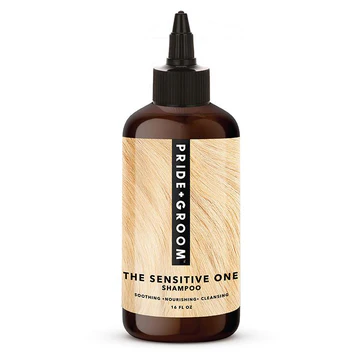
🛁 Pride + Groom “The Sensitive One” Shampoo
- Soothes skin & keeps coat shiny
- Bath time doubles as bonding time
- Calms anxious Dachshunds naturally
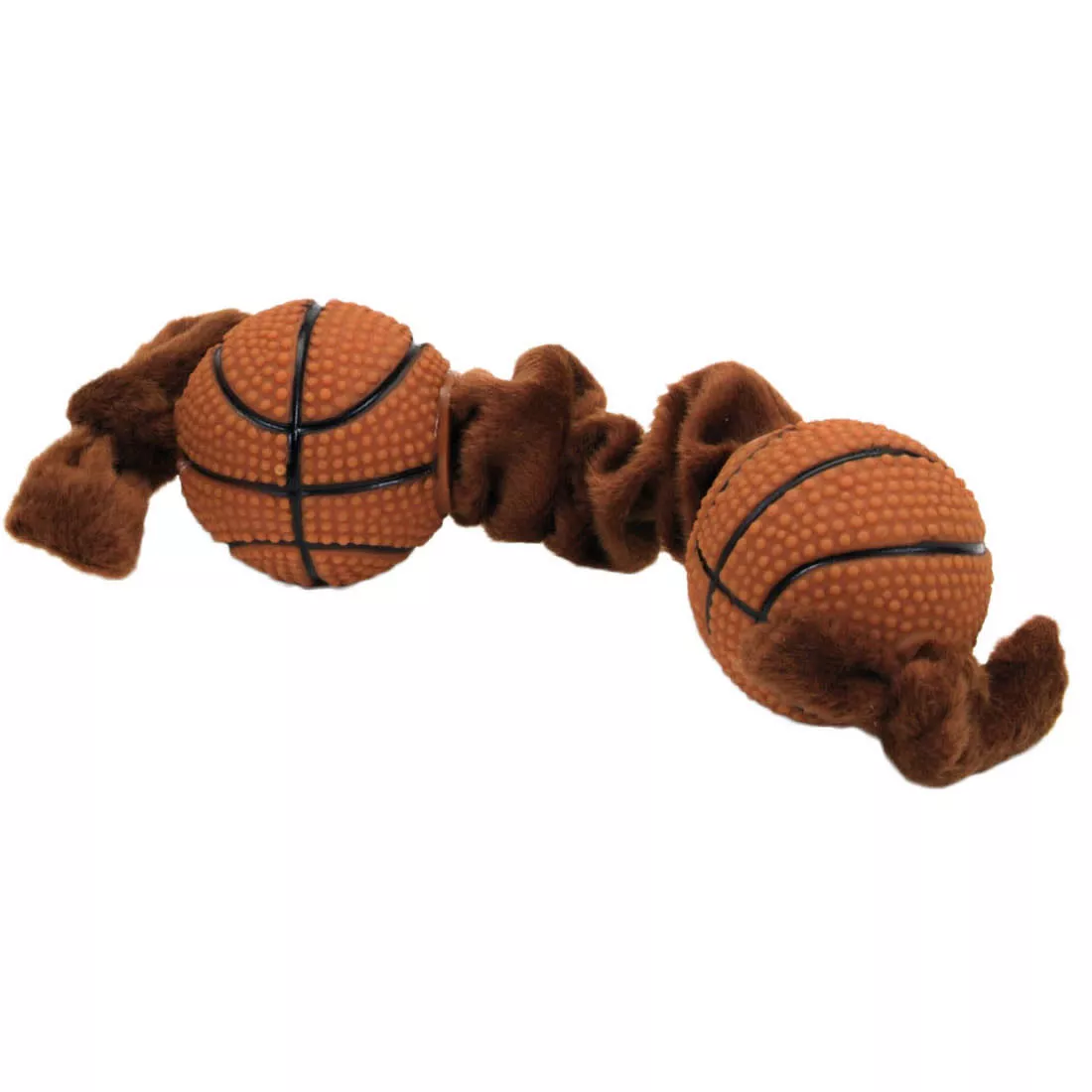
🦴 Coastal Pet Chew Toys
- Durable toys for endless chewing
- Helps redirect destructive habits
- Fun textures for dental health
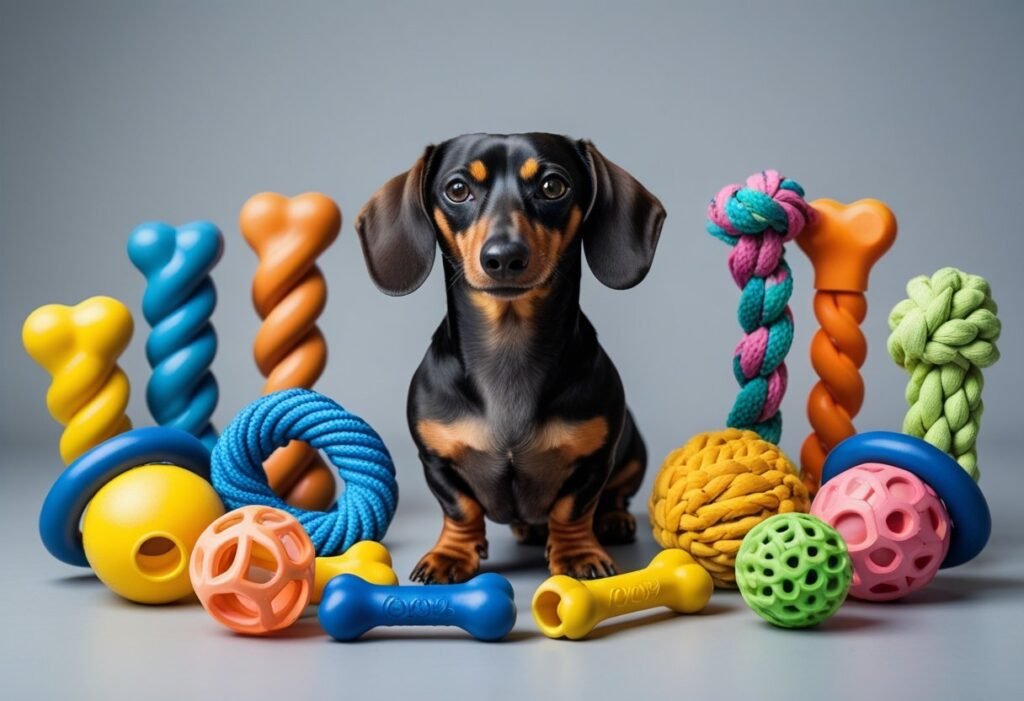
Supervision and Safe Confinement 👀
Keep an eye on your dachshund during free time, especially if they’re still a puppy 🐶. If you see them eyeing something they shouldn’t chew, redirect them right away 🔄.
Use a crate when you can’t supervise 📦. Make it cozy with bedding and toys, and make sure it’s roomy enough for comfort 🛏️.
Exercise pens give your dog more space than a crate but still keep them contained ➕. They’re great for open areas in your home 🏠.
Set up a dog-safe room for longer absences 🚪. Kitchens with tile floors usually work well since they’re easy to clean and have fewer chewable hazards ✨.
Don’t use confinement as punishment ❌. Your dachshund should see their safe space as a good thing, not a time-out zone ❤️.
Managing Ongoing Chewing Issues
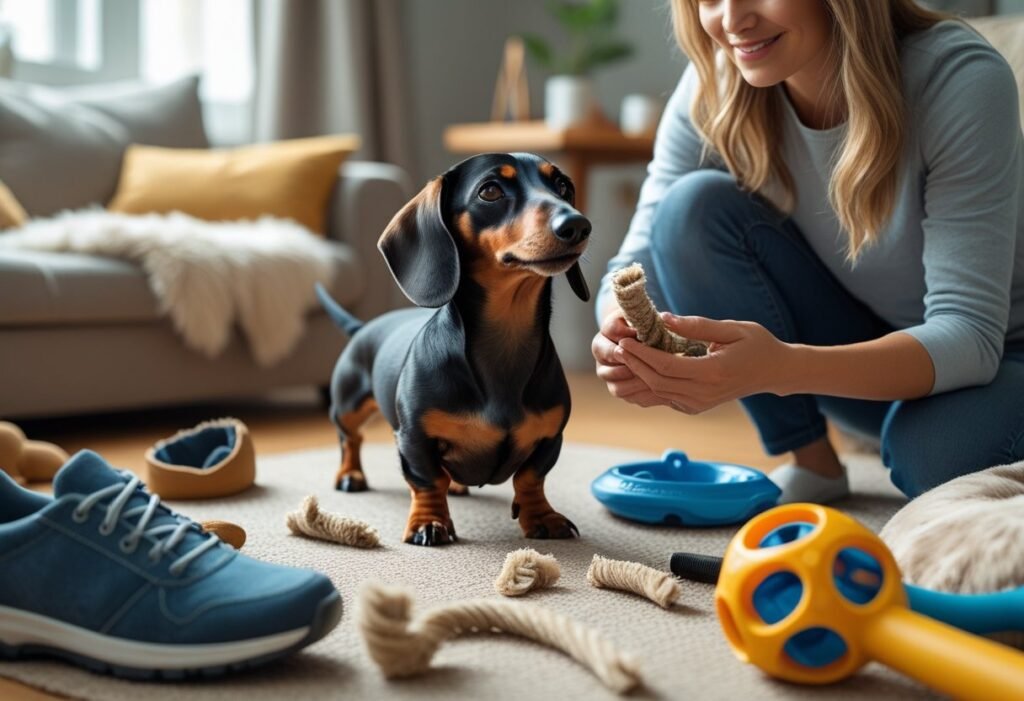
Some dachshunds just won’t quit chewing, no matter what you try 🐾. In those cases, you might need to step up your management game or call in a pro 🎯.
When to Seek Professional Help 🩺
If your dachshund keeps chewing despite all your efforts, it might be time for expert advice 📞. Here are some red flags 🚨:
Signs you need a professional:
- Chewing that causes more than $100 in property damage 💸.
- Self-harm, like chewing on their own paws or tail 🐾.
- Growling or snapping when you remove things from their mouth 😠.
- Chewing that looks compulsive or is driven by anxiety 💔.
Reach out to a certified dog behaviorist or your vet if your dachshund swallows dangerous stuff 🏥. They can suggest specialized training and might recommend:
- Behavior modification programs 🎓.
- Anti-anxiety meds if stress is behind the chewing 💊.
- Advanced training tailored to your dog’s needs 🐶.
Professional trainers can spot triggers you might miss 👀. Many offer home visits or group classes focused on stopping destructive behaviors 🏡.
🦴 Calm Focus Tools to Reduce Chewing Stress
- 💧 Petlibro Water Fountain — Keep your Dachshund hydrated and content; a calm body means less boredom-induced chewing.
- 🍖 Petcube Bites 2 — Reward calm, non-chewing behavior remotely and reinforce good habits while you’re away.
- 🪜 Majestic Pet Stairs — Prevent strain and frustration from jumping, which can trigger stress-related chewing.
- 🎽 Embark Pet Adventure Harness — Redirect energy with safe outdoor walks that tire your pup out and reduce destructive urges.
Maintaining Healthy Chewing Behavior
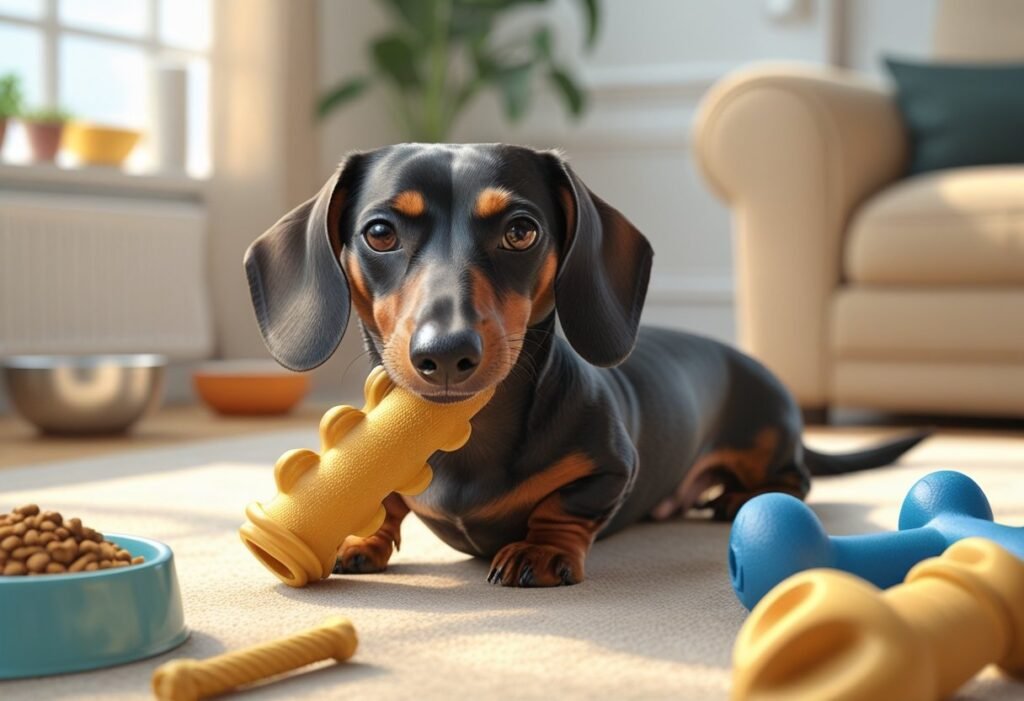
Keeping your dachshund’s chewing habits in check takes a mix of exercise and good dental care 🐾. Both satisfy their instincts and help keep your home intact 🏡.
Regular Exercise and Mental Stimulation 🎾
Dachshunds need daily exercise to burn off energy ⚡. Shoot for at least 30 to 45 minutes a day, split into shorter walks or play sessions if that’s easier 🚶.
Walking isn’t your only option. Try these activities too:
- Hide-and-seek with toys or treats 🔍.
- Fetch in a fenced yard 🐕.
- Puzzle toys that dispense food 🧩.
- Training sessions with new tricks 🎓.
Keep their mind busy 🧠. Rotate toys every week and use puzzle feeders so they have to work for their meals 🍲.
A tired dachshund is way less likely to chew up your stuff 😴. Regular play breaks up the day and keeps boredom at bay 🎯.
💛 Calm & Comfort Essentials to Stop Chewing Stress
- 🎽 Coastal Pet Harness (IVDD Version) – Support gentle, comfortable walks that release energy and reduce chewing caused by pent-up stress
- 🧴 Pride + Groom Grooming Tools Kit – Regular grooming provides tactile comfort and reduces anxiety-driven chewing behaviors
- 🫧 King Klean Dog Shampoo – Gentle cleansing and soothing coat care that helps calm irritation and licking or chewing at the skin
- 🎨 Purr & Mutt Personalized Dachshund Art – Celebrate your pup’s calm progress and create a peaceful environment at home
- 👕 Dog is Good Apparel & Gifts – Share positive energy and stay inspired on your journey to a happier, calmer Dachshund
🐾 A calm, well-cared-for Dachshund is far less likely to chew from anxiety—these essentials help nurture that balance every day.
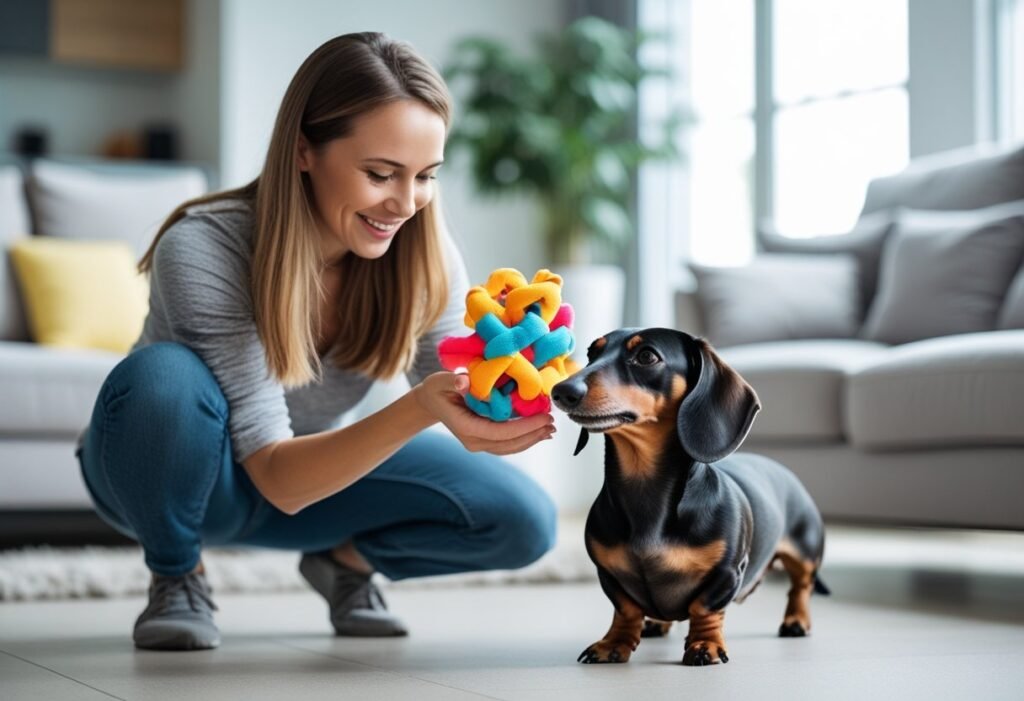
Routine Dental Care for Dachshunds 🦷
Dachshunds can have dental problems, so start brushing their teeth young 🪥. Use a toothbrush and toothpaste made for dogs 🐶.
Daily dental care should include:
- Brushing with dog toothpaste 🪥.
- Offering dental chews or toys 🦴.
- Checking for gum issues 👄.
Watch for these dental warning signs:
- Bad breath 😮💨.
- Red or bleeding gums ❤️.
- Trouble eating 🍽️.
- Lots of drooling 💧.
Schedule a professional cleaning with your vet every year 🏥. Vets can remove tartar that brushing can’t handle and check for breed-specific issues, like overcrowded teeth 🐾.
Dental-friendly chew toys do double duty—they satisfy chewing urges and help clean teeth ✨. Look for the Veterinary Oral Health Council (VOHC) seal when you shop ✅.
🐾 Don’t Miss Out!
Download our free Dachshund care guide to keep your furry friend happy and healthy.
Get Your Free Guide 🐶Frequently Asked Questions
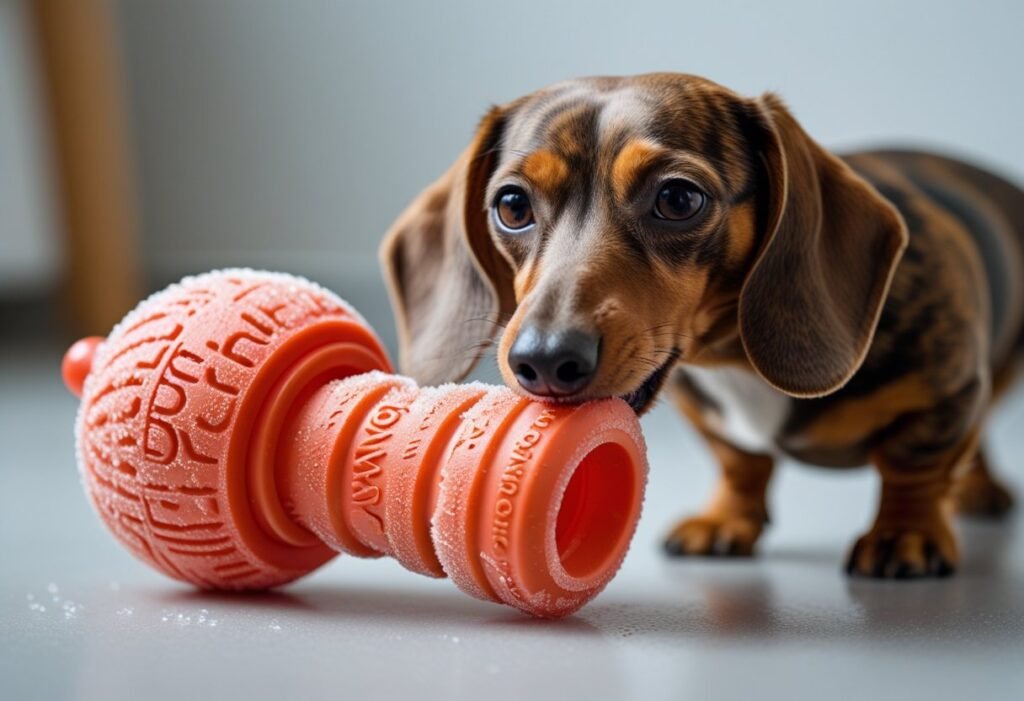
Dachshund owners run into plenty of chewing challenges 🐾. These questions cover training, age-related chewing, and how to manage this sometimes frustrating habit 🎯.
What are effective methods to discourage chewing behavior in dachshunds? 🦴
Give your dachshund lots of chew toys made for dogs 🐕. Rotate them often so your pup doesn’t lose interest 🔄.
Spray things your dachshund likes to chew with a bitter-tasting deterrent 🍋. It won’t hurt your pet, but it sure makes things less appealing 🚫.
Whenever you catch them chewing something off-limits, swap it for an approved toy and praise them when they use it 👏. Timing is everything here ⏱️.
Stick to a regular exercise routine 🐾. A tired dachshund is way less likely to chew out of boredom or pent-up energy ⚡.
Why do dachshunds engage in destructive chewing, and how can it be managed? 💡
Dachshunds chew a lot as puppies, mostly to ease teething discomfort 🍼. Tossing them a frozen chew toy can really help soothe those sore gums ❄️.
Boredom or anxiety often triggers destructive chewing 😟. Try puzzle toys or regular playtime to keep their minds busy 🧩.
Some dachshunds chew just to get your attention 👀. If that happens, keep calm and avoid making a big deal out of it 🤫.
Set up a dog-proof area when you can’t keep an eye on them 🚪. That way, they don’t get the chance to chew on things they shouldn’t 🚫.
How can you train a mini dachshund to stop chewing on inappropriate items? 🎓
Work on the “leave it” command during your training sessions 🗣️. Begin with treats, teaching your dachshund to ignore things on cue 🍪.
When your dachshund picks the right toy, reward them 🎉. Positive reinforcement goes a long way with these little guys 🐶.
Punishing them after the fact doesn’t work ❌. Dachshunds just don’t make the connection between old chewing and new discipline ⏳.
Clicker training can help mark the exact moment your pup makes a good choice about what to chew 🖱️. It’s a handy tool if you’re up for it ⚡.
At what age do dachshunds typically outgrow their chewing phase, if at all? ⏰
Chewing peaks between 3-6 months when they’re teething 🦷. Usually, things calm down after about 8 or 9 months 📉.
Some adult dachshunds still chew, though 🐾. If you skip training, that habit might just stick around for life 🔄.
By the time they’re 1 or 2 years old, most dachshunds settle into more mature chewing habits 🎯. But honestly, every dog is a bit different 🐕.
What strategies can prevent a dachshund from chewing objects while left alone? 🏡
Set up a safe space with a crate or pet gate before you leave 🚧. This keeps your dachshund out of trouble and helps them feel secure ❤️.
Take your dachshund for a solid 20-30 minute walk before heading out 🚶. Burning off some energy can really help curb destructive chewing ⚡.
Leave a mix of chew toys with different textures and challenges for them to explore 🎾. Stuff a Kong with frozen treats for extra-long entertainment ❄️.
Automated treat dispensers or puzzle toys can keep your dachshund busy while you’re gone 🤖. It might not solve everything, but it sure helps 👍.
What are the recommended ways to discipline a dachshund that bites or chews excessively? ⚠️
Focus on interruption, not punishment ✋. Try a sharp “no” or a quick clap to snap your dachshund out of chewing something they shouldn’t 👂.
Right after you interrupt them, hand over an appropriate toy 🦴. This way, your dachshund starts to figure out what’s okay to chew ✅.
If your dachshund starts mouthing or nipping during play, pause and step back for a moment ⏸️. Taking away your attention shows them that gentle play keeps the fun going, but rough behavior? Nope, that stops everything 🚫.
Skip physical punishment altogether ❌. It only ruins trust and can actually make your dachshund fearful or even aggressive —definitely not worth it 😔.

